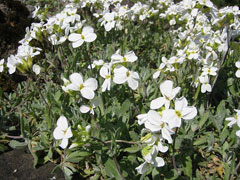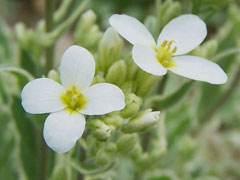 |
|
|
 |
| http://commons.wikimedia.org/wiki/User:Selso |
Translate this page:
Summary
Bloom Color: White.
Main Bloom Time: Early spring. Form: Spreading or horizontal.
Physical Characteristics

 Arabis caucasica is an evergreen Perennial growing to 0.2 m (0ft 8in) by 1 m (3ft 3in) at a medium rate.
Arabis caucasica is an evergreen Perennial growing to 0.2 m (0ft 8in) by 1 m (3ft 3in) at a medium rate.
See above for USDA hardiness. It is hardy to UK zone 4 and is not frost tender. It is in leaf all year, in flower from January to May, and the seeds ripen from April to June. The species is hermaphrodite (has both male and female organs) and is pollinated by Bees, Lepidoptera (Moths & Butterflies).
Suitable for: light (sandy), medium (loamy) and heavy (clay) soils, prefers well-drained soil and can grow in nutritionally poor soil. Suitable pH: mildly acid, neutral and basic (mildly alkaline) soils. It can grow in semi-shade (light woodland) or no shade. It prefers dry or moist soil and can tolerate drought.
UK Hardiness Map
US Hardiness Map
Synonyms
A. albida.
Plant Habitats
Ground Cover; East Wall. In. South Wall. In. West Wall. In.
Edible Uses
Edible Parts: Leaves
Edible Uses:
The leaves are used as a garnish in much the same way as watercress[183]. They are also sometimes used as a potherb[183].
References More on Edible Uses
Medicinal Uses
Plants For A Future can not take any responsibility for any adverse effects from the use of plants. Always seek advice from a professional before using a plant medicinally.
None known
References More on Medicinal Uses
The Bookshop: Edible Plant Books
Our Latest books on Perennial Plants For Food Forests and Permaculture Gardens in paperback or digital formats.

Edible Tropical Plants
Food Forest Plants for Hotter Conditions: 250+ Plants For Tropical Food Forests & Permaculture Gardens.
More

Edible Temperate Plants
Plants for Your Food Forest: 500 Plants for Temperate Food Forests & Permaculture Gardens.
More

More Books
PFAF have eight books available in paperback and digital formats. Browse the shop for more information.
Shop Now
Other Uses
A good ground cover plant for sunny positions[188, 197], forming a carpet[208].
Special Uses
Food Forest Ground cover
References More on Other Uses
Cultivation details
Landscape Uses:Alpine garden, Border, Ground cover, Rock garden. Easily grown in ordinary well-drained soil[1]. Prefers a poor soil[187]. Succeeds in partial shade[134] though it tends to become straggly[197]. Established plants are very tolerant of drought and grow very well on a dry bank[190], they also succeed when grown in walls[219, K]. A very ornamental plant[1], it is hardy to about -15°c[187], but can be rather invasive[200]. There are some named varieties selected for their ornamental value[187]. A good butterfly and moth plant[30]. Bees are attracted to the flowers. Plants resent root disturbance and are best put in their final positions whilst still small[134]. This species is closely related to A. alpina[200]. Special Features:
Attractive foliage. The plant is heat tolerant in zones 8 through 1. (Plant Hardiness Zones show how well plants withstand cold winter temperatures.
Plant Heat Zones show when plants would start suffering from the heat.
The Plant Heat Zone map is based on the number of "heat days" experienced in a given area where the temperature climbs to over 86 degrees F (30°C).
At this temperature, many plants begin to suffer physiological damage. Heat Zones range from 1 (no heat days) to 12 (210 or more heat days).
For example Heat Zone. 11-1 indicates that the plant is heat tolerant in zones 11 through 1.) For polyculture design as well as the above-ground architecture (form - tree, shrub etc. and size shown above) information on the habit and root pattern is also useful and given here if available. The plant growth habit is a clumper with limited spread [1-2].
References Carbon Farming Information and Carbon Sequestration Information
Temperature Converter
Type a value in the Celsius field to convert the value to Fahrenheit:
Fahrenheit:
The PFAF Bookshop
Plants For A Future have a number of books available in paperback and digital form. Book titles include Edible Plants, Edible Perennials, Edible Trees,Edible Shrubs, Woodland Gardening, and Temperate Food Forest Plants. Our new book is Food Forest Plants For Hotter Conditions (Tropical and Sub-Tropical).
Shop Now
Plant Propagation
Seed - it is best to surface sow the seed as soon as it is ripe in a light position in a cold frame[134]. Seed can also be sown in spring. It usually germinates in 2 - 3 weeks at 21°c[134]. When large enough to handle, prick the seedlings out into individual pots and plant them out in the summer. Division after flowering[111]. Very easy, the divisions can be planted out straight into their permanent positions if required. Cuttings in a shady border in summer[1].
Other Names
If available other names are mentioned here
Native Range
TEMPERATE ASIA: Armenia, Azerbaijan, Dagestan, Georgia, Iraq, Kyrgyzstan, Lebanon, Russian Federation, Syria, Tajikistan, Turkey, Turkmenistan,Iran. EUROPE: Ukraine, Krym, Albania, Bulgaria, Bosnia and Herzegovina, Greece (incl. Crete), Croatia, Italy (incl. Sicily), North Macedonia, Montenegro, Romania, Serbia, France (incl. Corsica), AFRICA: Algeria (north), Egypt, Morocco.
Weed Potential
Right plant wrong place. We are currently updating this section.
Please note that a plant may be invasive in one area but may not in your area so it's worth checking.
Conservation Status
IUCN Red List of Threatened Plants Status :

Growth: S = slow M = medium F = fast. Soil: L = light (sandy) M = medium H = heavy (clay). pH: A = acid N = neutral B = basic (alkaline). Shade: F = full shade S = semi-shade N = no shade. Moisture: D = dry M = Moist We = wet Wa = water.
Now available:
Food Forest Plants for Mediterranean Conditions
350+ Perennial Plants For Mediterranean and Drier Food Forests and Permaculture Gardens.
[Paperback and eBook]
This is the third in Plants For A Future's series of plant guides for food forests tailored to
specific climate zones. Following volumes on temperate and tropical ecosystems, this book focuses
on species suited to Mediterranean conditions—regions with hot, dry summers and cool, wet winters,
often facing the added challenge of climate change.
Read More
Expert comment
Author
Willd. ex Schltdl.
Botanical References
45200
Links / References
For a list of references used on this page please go here
Readers comment
© 2010, Plants For A Future. Plants For A Future is a charitable company limited by guarantee, registered in England and Wales. Charity No. 1057719, Company No. 3204567.